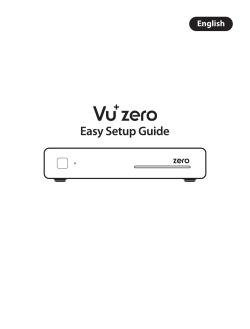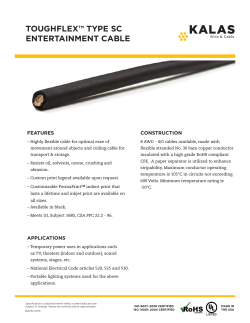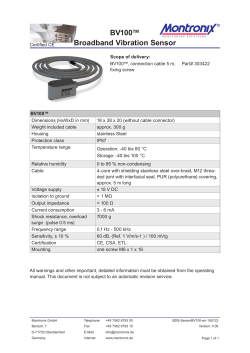
Troubleshooting Job Aid
Troubleshooting: ViP and earlier Version 7.2 1. Preparation • Ensure the SBSM is charged • Review the account notes • Contact customer if call history shows no contact was made or you require directions or security gate access 2. Customer Confirmation • Bring the SBSM when greeting the customer •“I understand you are having an issue with ______. Can you show me where you are having this issue?” • Ask probing questions, such as: •“Is the issue on all TVs or just one TV?” •“Is the issue constant or intermittent?” •“Have you recently moved/relocated the system?” 3. Initial Troubleshooting with Customer • Attempt to recreate the problem (if possible) At both TV1 and TV2: • Verify all devices are plugged in and turned on • Verify all cables are secured properly • Verify the TV is on the correct input/channel • If applicable, verify that the smart card is inserted properly If the receiver is operational: • Ensure the remote is programmed properly (codes, address, etc.) • Ensure the remote and receiver are communicating properly • Check the system info screen for errors 4. Set up Limit Scan • • • • • Unplug the receiver from the power outlet Power on the SBSM Set the SBSM configuration to match the dish/switch configuration Unhook the satellite feed from the receiver Attach the SBSM to the satellite feed 5. Limit Scan Behind the STB with Customer • On the SBSM, press MENU and then press LIMIT SCAN • Press the LNB OFF soft key to cycle through the orbitals • Look for a PASS or FAIL alert FAIL A failed limit scan will occur if: • At least one transponder’s IRD is less than the Req • At least one transponder is less than -50.0 dBm Inform the customer: “There seems to be an issue with the signal path. I will do further tests and let you know once the issue is resolved.” Go to Step 6a PASS A passed limit scan will occur if: • All transponders’ IRD is greater than the Req • All transponders’ dBm is greater than -50.0 dBm This means the issue is isolated between the STB and TV Inform the customer: “The signal strength is good and the issue seems to be isolated to this area. I will do further tests and will let you know once the issue is resolved.” Go to Step 6b Troubleshooting: ViP and earlier Version 7.2 6a. Signal Troubleshooting STEPS FAIL PASS a. Does the wall plate have a low-frequency barrel in it? Replace and retest Next step b. Limit scan at STB side of the ground block/switch Next step Check and replace any defective components between the ground block/switch and STB, then go to (f) c. Limit scan at the dish side of the ground block/switch Next step Replace the ground block/switch, then go to (f) d. Limit scan at the dish Next step Check and replace any defective components between the dish and ground block/switch, then go to (f) e. Verify the mount is secure and positioned properly Secure and peak dish Replace the LNBF, then go to (f) f. Repeat the limit scan behind the STB Go to (b) Go to (g) g. Test outlet, plug in the receiver, and run a check switch Go to Step 6b (a) Go to (h) h. Perform a limit scan behind all other STBs. If no other STBs exist, continue to Step 7 - Final Quick Checks Go to Step 6a (a) Go to Step 7: Final Quick Checks 6b. STB to TV Troubleshooting STEPS FAIL PASS a. Run limit scan around each component (ex. diplexer, separator, or triplexer) Replace any defective components. Reconnect components and go to (h) Reconnect the coaxial cable and go to next step *A separator/triplexer will only show odd or even transponders, which will display “fail” on the SBSM b. Test outlet, plug in receiver, and see if the TV picture is coming in clear and consistent Go to (d) Go to (c) c. Ensure TV picture contains no error message Address error message and if needed, replace the receiver Go to (i) d. Try using the same cable in a different port on the TV Next step Use the same cable in the different port, then go to (i) e. Try using a replacement cable Next step Use a replacement cable, then go to (i) f. Without downgrading, try using a different kind of cable Next step connection (ex. If HDMI, try using a component cable) Use a new cable connection, then go to (i) g. Reset the TV’s factory settings, with customer approval Go to (i) Next step h. Plug another device into the same port on the TV, if possible Possible TV issue, test on another TV Replace the receiver, then go to (i) i. Perform a limit scan behind all other STBs. If no other STB exist, continue to Step 7: Final Quick Checks Go to Step 7: Final Quick Checks 7. Final Quick Checks Dish and Mount • Clear line of sight • Secure mount and lags • Enough lag screws • Level mast • Ground mast Go to Step 6a (a) Cabling and Components • Cable is RG6 and in good condition • DNS approved hardware • All fittings secure and torqued • Drip-loops installed properly Grounding • Approved ground block • Approved ground source • Grounding component installed properly Connectivity and Customer Education • Verify connectivity is present and functioning • Review troubleshooting findings with customer • Ensure customer is confident with system/remote • Review and quiz customer on 5 troubleshooting steps
© Copyright 2025










